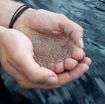(Press-News.org) Quasars are galaxies with very active supermassive black holes at their centres. These black holes are surrounded by spinning discs of extremely hot material that is often spewed out in long jets along their axes of rotation. Quasars can shine more brightly than all the stars in the rest of their host galaxies put together.
A team led by Damien Hutsemékers from the University of Liège in Belgium used the FORS instrument on the VLT to study 93 quasars that were known to form huge groupings spread over billions of light-years, seen at a time when the Universe was about one third of its current age.
"The first odd thing we noticed was that some of the quasars' rotation axes were aligned with each other -- despite the fact that these quasars are separated by billions of light-years," said Hutsemékers.
The team then went further and looked to see if the rotation axes were linked, not just to each other, but also to the structure of the Universe on large scales at that time.
When astronomers look at the distribution of galaxies on scales of billions of light-years they find that they are not evenly distributed. They form a cosmic web of filaments and clumps around huge voids where galaxies are scarce. This intriguing and beautiful arrangement of material is known as large-scale structure.
The new VLT results indicate that the rotation axes of the quasars tend to be parallel to the large-scale structures in which they find themselves. So, if the quasars are in a long filament then the spins of the central black holes will point along the filament. The researchers estimate that the probability that these alignments are simply the result of chance is less than 1%.
"A correlation between the orientation of quasars and the structurethey belong to is an important prediction of numerical models of evolution of our Universe. Our data provide the first observational confirmation of this effect, on scales much larger that what had been observed to date for normal galaxies," adds Dominique Sluse of the Argelander-Institut für Astronomie in Bonn, Germany and University of Liège.
The team could not see the rotation axes or the jets of the quasars directly. Instead they measured the polarisation of the light from each quasar and, for 19 of them, found a significantly polarised signal. The direction of this polarisation, combined with other information, could be used to deduce the angle of the accretion disc and hence the direction of the spin axis of the quasar.
"The alignments in the new data, on scales even bigger than current predictions from simulations, may be a hint that there is a missing ingredient in our current models of the cosmos," concludes Dominique Sluse.
INFORMATION:
More information
This research was presented in a paper entitled "Alignment of quasar polarizations with large-scale structures", by D. Hutsemékers et al., to appear in the journal Astronomy & Astrophysics on 19 November 2014.
The team is composed of D. Hutsemékers (Institut d'Astrophysique et de Géophysique, Université de Liège, Liège, Belgium), L. Braibant (Liège), V. Pelgrims (Liège) and D. Sluse (Argelander-Institut für Astronomie, Bonn, Germany; Liège).
ESO is the foremost intergovernmental astronomy organisation in Europe and the world's most productive ground-based astronomical observatory by far. It is supported by 15 countries: Austria, Belgium, Brazil, the Czech Republic, Denmark, France, Finland, Germany, Italy, the Netherlands, Portugal, Spain, Sweden, Switzerland and the United Kingdom. ESO carries out an ambitious programme focused on the design, construction and operation of powerful ground-based observing facilities enabling astronomers to make important scientific discoveries. ESO also plays a leading role in promoting and organising cooperation in astronomical research. ESO operates three unique world-class observing sites in Chile: La Silla, Paranal and Chajnantor. At Paranal, ESO operates the Very Large Telescope, the world's most advanced visible-light astronomical observatory and two survey telescopes. VISTA works in the infrared and is the world's largest survey telescope and the VLT Survey Telescope is the largest telescope designed to exclusively survey the skies in visible light. ESO is the European partner of a revolutionary astronomical telescope ALMA, the largest astronomical project in existence. ESO is currently planning the 39-metre European Extremely Large optical/near-infrared Telescope, the E-ELT, which will become "the world's biggest eye on the sky".
Links
* Research paper: http://www.eso.org/public/archives/releases/sciencepapers/eso1438/eso1438a.pdf
* Photos of the VLT: http://www.eso.org/public/images/archive/category/paranal/
Contacts
Damien Hutsemékers
Institut d'Astrophysique et de Géophysique -- Université de Liège
Liège, Belgium
Tel: +32 4 366 9760
Email: hutsemekers@astro.ulg.ac.be
Dominique Sluse
Institut d'Astrophysique et de Géophysique -- Université de Liège
Liège, Belgium
Tel: +32 4 366 9797
Email: dsluse@ulg.ac.be
Richard Hook
ESO education and Public Outreach Department
Garching bei München, Germany
Tel: +49 89 3200 6655
Cell: +49 151 1537 3591
Email: rhook@eso.org
PROVIDENCE, R.I. [Brown University] -- A widely presumed problem of aging is that the brain becomes less flexible -- less plastic -- and that learning may therefore become more difficult. A new study led by Brown University researchers contradicts that notion with a finding that plasticity did occur in seniors who learned a task well, but it occurred in a different part of the brain than in younger people.
When many older subjects learned a new visual task, the researchers found, they unexpectedly showed a significantly associated change in the white matter of the brain. ...
Professor Dan Davis and his team at the Manchester Collaborative Centre for Inflammation Research, working in collaboration with global healthcare company GSK, investigated how different types of immune cells communicate with each other - and how they kill cancerous or infected cells. Their research has been published in Nature Communications.
Professor Davis says: "We studied the immune system and then stumbled across something that may explain why some drugs don't work as well as hoped. We found that immune cells secrete molecules to other cells across a very small ...
A recent study by an Indiana University researcher has found that adolescents' alcohol use is influenced by their close friends' use, regardless of how much alcohol they think their general peers consume.
Jonathon Beckmeyer, assistant professor in the Department of Applied Health Science at the IU School of Public Health-Bloomington and author of the study, said his research generally focuses on the onset of teen alcohol use and how their social relationships shape those experiences.
"We've known for a long time that friends and peers have an influence on individual ...
SAN FRANCISCO, Nov. 19, 2014 -- Hox genes are master body-building genes that specify where an animal's head, tail and everything in between should go. There's even a special Hox gene program that directs the development of limbs and fins, including specific modifications such as the thumb in mice and humans. Now, San Francisco State University researchers show that this fin- and limb-building genetic program is also utilized during the development of other vertebrate features.
The discovery means this ancient genetic program is employed in a variety of features beyond ...
A new study, published online in Brain: A Journal of Neurology today, followed 43,368 individuals in Sweden for an average of 12.6 years to examine the impact of physical activity on Parkinson's disease risk. It was found that "a medium amount" of physical activity lowers the risk of Parkinson's disease.
Karin Wirdefeldt of the Karolinska Institutet in Stockholm and her colleagues used the Swedish National March Cohort to analyse comprehensive information on physical activity of all kinds. They assessed household and commuting activity, occupational activity, leisure ...
A new study led by researchers at King's College London in collaboration with the US Consortium of Food Allergy Research and the University of Dundee has found a strong link between environmental exposure to peanut protein during infancy (measured in household dust) and an allergic response to peanuts in children who have eczema early in life.
Around two per cent of school children in the UK and the US are allergic to peanuts. Severe eczema in early infancy has been linked to food allergies, particularly peanut allergy.
The study, published in the Journal of Allergy ...
New research on a number of Canadian lakes show that historical acid deposits as a result of industry have greatly reduced calcium levels in the water - dramatically impacting populations of calcium-rich plankton such as Daphnia water fleas that dominate these ecosystems.
Falling calcium levels mean Daphnia cannot get the nutrients they need to survive and reproduce, and are consequently consuming less food and becoming more susceptible to predators, leaving more algae for other organisms to feed on.
This has left a small jelly-clad organism called Holopedium to take ...
People with airway diseases, including asthma and chronic obstructive pulmonary disease (COPD), have a higher incidence of inflammatory bowel disease, such as Crohn's disease and ulcerative colitis, according to the findings of a new study.
The research, which is published online today (19 November 2014) in the European Respiratory Journal, is the first population-based study to examine the association between airway diseases and the incidence of bowel disease. The news comes on World COPD Day, which aims to improve awareness and care of COPD.
The results showed that ...
Researchers from the University of East Anglia (UEA) are a step closer to enhancing the generation of clean energy from bacteria.
A report published today shows how electrons hop across otherwise electrically insulating areas of bacterial proteins, and that the rate of electrical transfer is dependent on the orientation and proximity of electrically conductive 'stepping stones'.
It is hoped that this natural process can be used to improve 'bio batteries' which could produce energy for portable technology such as mobile phones, tablets and laptops - powered by human ...
People taking part in this year's Flusurvey, the UK's biggest crowd-sourced study of influenza will for the first time be offered a swab to confirm if their symptoms are caused by a flu virus or not as part of a new collaboration with i-sense. Data from social media and internet searches will also be combined with Flusurvey, allowing flu trends to be monitored across the UK more accurately and earlier than ever before.
Flusurvey scientists at the London School of Hygiene & Tropical Medicine will analyse weekly information relating to symptoms, provided in an online questionnaire ...




